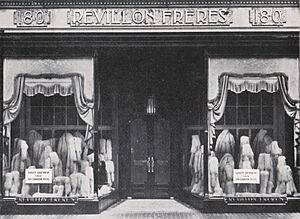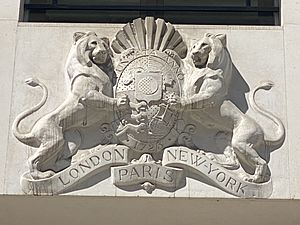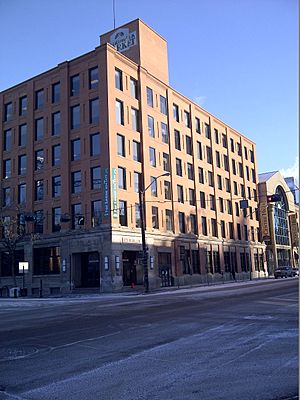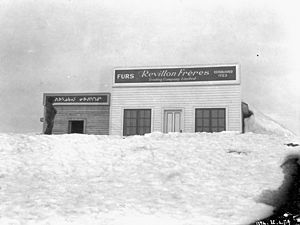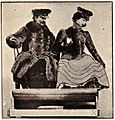Revillon Frères facts for kids
| Industry | Furs and luxury products |
|---|---|
| Founded | 1839 |
| Founder | Louis-Victor Revillon |
| Defunct | 1982 |
| Headquarters | Paris |
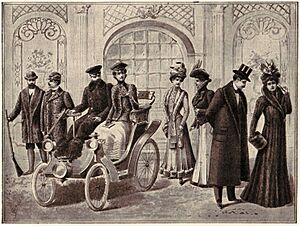
Revillon Frères (which means Revillon Brothers) was a famous French company. It sold furs and other fancy, expensive items. The company started in Paris in 1723 as "la Maison Givelet."
Louis-Victor Revillon bought the company in 1839. It soon became the biggest fur company in France. Revillon Frères opened stores in London in 1869 and in New York in 1878.
By the late 1800s, Revillon had stores in Paris, London, New York City, and Montreal. They bought most of their furs from big markets in places like Moscow and Leipzig, Germany. They also bought furs at large yearly fairs in Russia.
Between 1908 and 1909, Revillon Frères opened new fur trading posts. These were in faraway places like Siberia, Mongolia, and Turkestan. By 1912, the company had 125 fur trading posts. These posts were spread across America and Siberia.
In the 1960s, Revillon bought Grauer Furs. This was a top fur making company in New York. Later, in 1970, Revillon started supplying furs to the famous store Saks 5th Avenue. This partnership lasted until 1995.
In 1982, a large store company called Cora bought Revillon. It became Cora-Revillon's luxury part. Today, Revillon is a separate company. Besides furs, it also makes perfume.
Contents
Fur Trading in Canada (1893-1936)
In 1899, Revillon Frères opened a large warehouse in Edmonton, Alberta, Canada. By 1903, they had 23 stores across Canada. The company, owned by Victor Revillon, built a network of fur-trading posts in northern Canada. They were direct rivals to the Hudson's Bay Company (HBC).
Revillon's Canadian operations had two main parts. The western part had posts mostly in northern Alberta, Saskatchewan, and Manitoba. For example, in 1911, they had 13 posts north and west of Athabasca Landing. They also had 10 more posts from The Pas to Nueltin Lake.
The eastern part was in the James Bay and Ungava Bay areas of northern Quebec. Revillon used its own ships to supply these posts. By 1909, Revillon had 48 stores in its Eastern Arctic area. Many Inuit villages in Nunavik, northern Quebec, are located where Revillon Frères trading posts once stood.
In 1912, the company became "Revillon Frères Trading Company Ltd." in Canada. In 1926, the Hudson's Bay Company bought 54% of Revillon's fur trade business. By 1936, HBC owned the company completely. In 1938, its name changed to "Rupert's Land Trading Company."
Revillon Frères helped pay for the 1922 film Nanook of the North. This movie was filmed near one of their trading posts in Inukjuak, Quebec. It is thought to be Canada's first documentary film.
Ilya Andreyevich Tolstoy, the grandson of the famous writer Leo Tolstoy, stayed at a Revillon Frères post in 1928-1929. He was part of a group trying to film caribou for a movie called The Silent Enemy. This silent film was released in 1930.
The Glenbow Museum in Calgary has over 300 photos of Revillon posts, ships, and items they sold. Many photos were taken by Samuel Herbert Coward. He was the director of Revillon Frères Trading Company Ltd. in Canada from 1904 to 1931. There is also a Revillon Frères Museum in Moosonee, Ontario, but it has been closed for several years.
Revillon Trading Posts in Canada
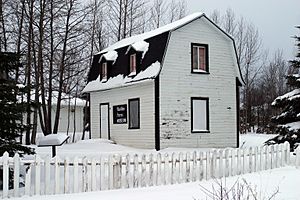
Revillon Frères had many trading posts across Canada. These posts helped them buy furs from local trappers and sell goods.
Western Division Posts
- Edmonton, Alberta: This city had a major store and warehouse. It was the main office for many posts in the west.
- Athabasca Landing, Alberta
- Grande Prairie, Alberta
- Lesser Slave Lake, Alberta
- Peace River, Alberta
- Fort Vermilion, Alberta
- Prince Albert, Saskatchewan: This city also had a major store. It was the main office for other posts in Saskatchewan and Manitoba.
- La Ronge, Saskatchewan
- Île-à-la-Crosse, Saskatchewan
- The Pas (closed in 1923)
- Brochet, Manitoba
Eastern Division Posts
- Montreal: This city had a major store. It was the main office for posts in the east.
- Wakeham Bay, Quebec
- Fort Chimo, Ungava Bay, Quebec
- Port Harrison, Hudson Bay, Quebec
- Fort George, James Bay, Quebec
- Rupert House, Quebec
- Kuujjuarapik, Quebec (Whale River)
- Attawapiskat First Nation, Ontario
- Fort Albany, Ontario
- Moose Factory, Ontario (near Moosonee)
Revillon Boats
Revillon Frères used a fleet of boats to reach their distant trading posts. These boats helped transport furs and supplies. Some of their boats included:
- Stord (a steamer)
- Violet
- Adventure (a large steamer)
- Albert Revillon (a three-mast schooner)
- Jean Revillon (later renamed Fort James; this ship was the first to sail around North America in 1928-29)
Images for kids
-
Paletots by Revillon Frères at the Exposition Universelle (1900).
-
Furs by Revillon Frères


